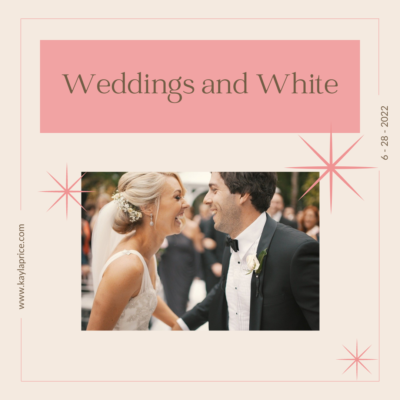
The traditional wedding season us upon and “what to wear?” is always the question. Decades ago, our foremothers stayed true to the rules of not wearing white to a wedding as to not compete color wise with the bride. Many of us were also taught not to wear black to a wedding since black is the color of mourning.
These days, you may see a bride in white or pink or red or floral or whatever other color or pattern expresses her personality. What is a wedding guest to do? From time-to-time, a bride might provide instructions on the invitation, asking attendees to wear blue or whatever her preference may be. In other instances, the chosen wedding dress may be known to the guests. I recall watching an episode of Say Yes to the Dress when the bride wanted a red dress. Unless she asks that the guests all wear red as well, and if I knew she had chosen a red dress, I would refrain from wearing red or red floral or anything that might be considered competing.
The best thing to do if you are the bride who has chosen a not-so-traditional color is the assist the guest by providing information. Just as the small type at the bottom of invitations provides dress codes (black tie optional or white tie), why not provide guidance on color choice (please refrain from wearing yellow)? If you are wearing the traditional white or candlelight, no such guidance is required. The addition of one simple line on the invitation will prevent a bride and/or a guest from feeling uncomfortable at the ceremony. Otherwise, if a guest shows up in bubblegum pink which exactly matches the bride’s dress, no one can blame the guest since she had no way to know.
As a guest, if you suspect a bride might not be traditional with her choices and no directives are provided, you could inquire with someone closer to her to find out if there are any colors the bride wants the guests to avoid. Be careful not to phrase it as, “Is the bride wearing white?” Those of a certain age will assume the question refers to something else.
If no guidance was provided on the invitation, and there is no way to find out more information, then the best thing to do is to follow standing wedding etiquette and avoid white, ivory, and black.
However, another more modern application does allow for black to be worn if the wedding is a formal, evening affair. Black is a commonly worn color for formal events, and weddings are no exception (unless the bride asks that no one wear black). Guests at daytime or casual weddings should still generally avoid black.
Since floral patterns are such a standard for summer dresses, one might wonder how much white in the pattern makes it a white dress. That is a call a guest will have to make, but for me, if the predominant color is white, then I would not wear it to a wedding. Each dress will need to have its own form of measure, but as a rule of thumb, I would consider less than a quarter of the dress being white to be okay. If you aren’t sure, then select another dress. Better safe than sorry in this case.
I have heard rumblings from guests who were asked to wear a certain color or avoid a certain color at weddings or other events. I have even known of individuals blatantly ignoring the directives. In my opinion that just seems petty. As a guest, we should want to please our hosts, not complicate matters. If we are not able to do that, then it is best we decline the invitation.
How do you feel about being asked to refrain from wearing a certain color or asked to wear a specific color? Do you think guests should adhere to old guidelines for what colors are unacceptable for wedding?
Visit me at:
YouTube: Kayla Price – YouTube
Instagram: @AtHomeWithKaylaPrice
Pinterest: @AtHomeWithKayla
Twitter: @AtHomeKayla
All items have been purchased and paid for by me. I am including these links for your convenience to find products mentioned. As an Amazon Associate, I earn a small commission from qualifying purchases. This does not increase the price you pay. Any earnings will help me to support and improve my blog.

